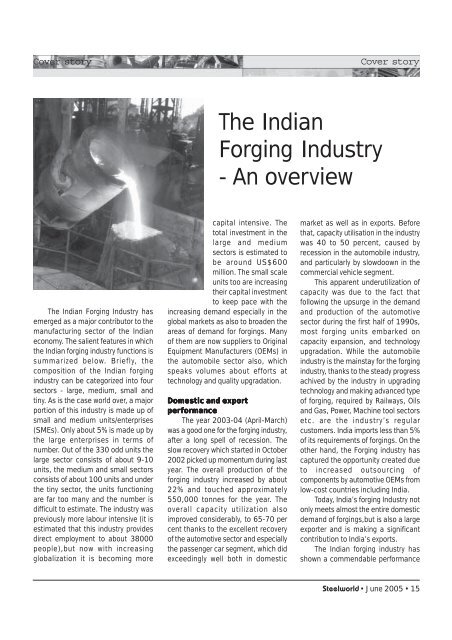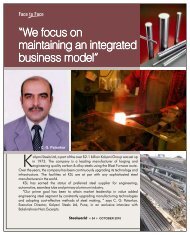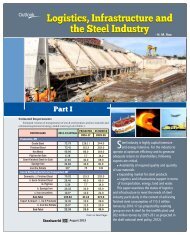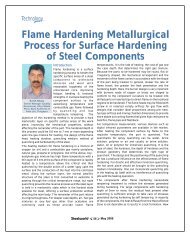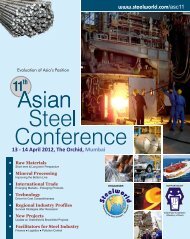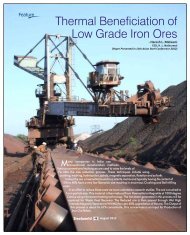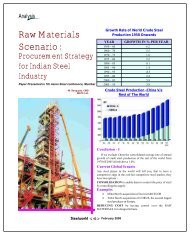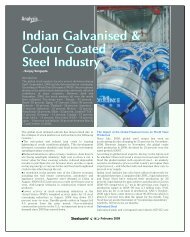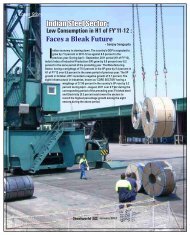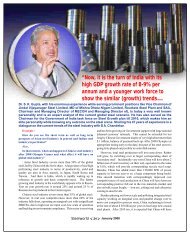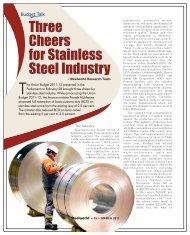Cover Story - The Indian forging Industry - An overview - Steelworld
Cover Story - The Indian forging Industry - An overview - Steelworld
Cover Story - The Indian forging Industry - An overview - Steelworld
- No tags were found...
Create successful ePaper yourself
Turn your PDF publications into a flip-book with our unique Google optimized e-Paper software.
<strong>Cover</strong> story<strong>Cover</strong> story<strong>The</strong> <strong>Indian</strong>Forging <strong>Industry</strong>- <strong>An</strong> <strong>overview</strong><strong>The</strong> <strong>Indian</strong> Forging <strong>Industry</strong> hasemerged as a major contributor to themanufacturing sector of the <strong>Indian</strong>economy. <strong>The</strong> salient features in whichthe <strong>Indian</strong> <strong>forging</strong> industry functions issummarized below. Briefly, thecomposition of the <strong>Indian</strong> <strong>forging</strong>industry can be categorized into foursectors - large, medium, small andtiny. As is the case world over, a majorportion of this industry is made up ofsmall and medium units/enterprises(SMEs). Only about 5% is made up bythe large enterprises in terms ofnumber. Out of the 330 odd units thelarge sector consists of about 9-10units, the medium and small sectorsconsists of about 100 units and underthe tiny sector, the units functioningare far too many and the number isdifficult to estimate. <strong>The</strong> industry waspreviously more labour intensive (it isestimated that this industry providesdirect employment to about 38000people),but now with increasingglobalization it is becoming morecapital intensive. <strong>The</strong>total investment in thelarge and mediumsectors is estimated tobe around US$600million. <strong>The</strong> small scaleunits too are increasingtheir capital investmentto keep pace with theincreasing demand especially in theglobal markets as also to broaden theareas of demand for <strong>forging</strong>s. Manyof them are now suppliers to OriginalEquipment Manufacturers (OEMs) inthe automobile sector also, whichspeaks volumes about efforts attechnology and quality upgradation.Domestic and exportperformance<strong>The</strong> year 2003-04 (April-March)was a good one for the <strong>forging</strong> industry,after a long spell of recession. <strong>The</strong>slow recovery which started in October2002 picked up momentum during lastyear. <strong>The</strong> overall production of the<strong>forging</strong> industry increased by about22% and touched approximately550,000 tonnes for the year. <strong>The</strong>overall capacity utilization alsoimproved considerably, to 65-70 percent thanks to the excellent recoveryof the automotive sector and especiallythe passenger car segment, which didexceedingly well both in domesticmarket as well as in exports. Beforethat, capacity utilisation in the industrywas 40 to 50 percent, caused byrecession in the automobile industry,and particularly by slowdoown in thecommercial vehicle segment.This apparent underutilization ofcapacity was due to the fact thatfollowing the upsurge in the demandand production of the automotivesector during the first half of 1990s,most <strong>forging</strong> units embarked oncapacity expansion, and technologyupgradation. While the automobileindustry is the mainstay for the <strong>forging</strong>industry, thanks to the steady progressachived by the industry in upgradingtechnology and making advanced typeof <strong>forging</strong>, required by Railways, Oilsand Gas, Power, Machine tool sectorsetc. are the industry’s regularcustomers. India imports less than 5%of its requirements of <strong>forging</strong>s. On theother hand, the Forging industry hascaptured the opportunity created dueto increased outsourcing ofcomponents by automotive OEMs fromlow-cost countries including India.Today, India’s <strong>forging</strong> <strong>Industry</strong> notonly meets almost the entire domesticdemand of <strong>forging</strong>s,but is also a largeexporter and is making a significantcontribution to India’s exports.<strong>The</strong> <strong>Indian</strong> <strong>forging</strong> industry hasshown a commendable performance<strong>Steelworld</strong> • June 2005 • 15
<strong>Cover</strong> storyby registering export growth of almost30%. Exports are now at US$ 180million. Technological developmentshave also contributed for the industry’ssteady growth in exports, which werea mere US$ 20 million or so ten yearsago. <strong>The</strong> major markets are USA,Europe, China etc. However, not morethan 20 to 25 manufacturing units areengaged in direct exports.Exports growthBharat Forge Ltd, the country’slargest exporters increased export fromUS$ 60million in 2002-03 to US$ 74million in 2003-04, a growth of 23%.Other prominent exporting companieslike M M Forgings Ltd., Super AutoForge Ltd., R N Gupta & Co., VictorForgings showed their excellent exportperformance by shipping more than40% to 100% of their production duringthe year.Inorganic growth was anotherstrategy employed by <strong>Indian</strong>companies to establish a globalpresence. Bharat Forge acquired CarlDan Peddinghaus, the second largest<strong>forging</strong> company in Germany, in 2004.<strong>The</strong> CDP acquisition has made BharatForge the second largest <strong>forging</strong>company in the world. SundaramFasteners acquired the prestigious<strong>forging</strong> unit of Dana Corp, UK. This hasgiven SFL a firm foothold in the UKand other European countries. Besides,auto part maker Amtek Auto Ltd hasacquired the entire equity stake of theGWK Group in UK. <strong>The</strong> industry expectsthe kind of inorganic growth to furtherincrease in the years that follow.Increasing domestic demandApart from the increase in steelprices, the industry faced shortages onaccount of lower availability of <strong>forging</strong>quality steel caused due to the closureof many mini steel plants anddiscontinuation of the production bysome of the major steel plants. <strong>The</strong>problem was further aggravated dueto the restrictions on import of steeland high import duty. Subsequently, theGovt. initiated steps to facilitateimports and import duties have alsobeen reduced. However, the industryis continuing efforts to optimize its coststructure. In addition to steel,increasing cost of other inputs likeenergy/power and fuel place an addedpressures on <strong>forging</strong> companies.Major constraints / key issues<strong>The</strong> major constraints (on thedomestic and export front) faced bythe <strong>forging</strong> industry during the yearwere mainly - high import duty andvolatile international prices of <strong>forging</strong>quality steel coupled with thereluctance of customers tocompensate this, slow recovery oftractor industry, inefficient economiesof scale, need to strictly adhere to thestringent environment norms, lack ofadequate backward/forward Linkages,difficulties in consolidation ofcapacities.<strong>The</strong> industry also faces hindranceson the export front which are thefollowing: impact of the volatile foreignexchange rates, reluctance of theoverseas buyers to compensate for thesteel price increases in India whichwere around 1 to 1.5 times more thaninternational prices, inadequateinvestment in technology upgradation,inadequate R & D and training forcoping with the demands of the exportmarket, inadequate testing andvalidation facilities for smaller <strong>forging</strong>companies, inadequate overseasmarketing support facilities and costcompetitiveness adversely affecteddue to constant cost escalation.Future outlookEconomic indicators suggest thata global economic recovery is in theoffing. <strong>The</strong> US economy grew by 3.1%in 2003, surpassing all the other majordeveloped economies. US economicgrowth in 2004 is expected to be inthe region of 4.5% to 5%. <strong>The</strong>Japanese economy that had been ina state of stagnation for the past sixyears, registered growth of 2.7% in2003. China continued on its blisteringgrowth path, recording GDP growth of9% in 2003. <strong>The</strong> Chinese economycontinued to grow at a high level in2004. <strong>The</strong> same level of growth isexpected to continue this year as well.Economic growth in Europe, thoughmore sedate was satisfactory in 2004and is expected to surge this year aswell. As regards the <strong>Indian</strong> economy,the country recorded GDP growth of8.2% in 2003-04. <strong>The</strong> <strong>Indian</strong>economy is projected to grow at therate of 6.5 percent this fiscal. Thismakes India the second fastestgrowing economy in the world. This isundoubtedly a strong platform for theGovt.to launch the next phase ofreforms (which in all probability it will)through which past gains made by the<strong>Indian</strong> economy can be consolidatedupon and the economy placed on apath of consistent high growth.<strong>The</strong> future looks encouraging forthe <strong>forging</strong> industry in terms of theexpected surge in global demand. Asa result of liberalisation, more MNCshave entered the domestic automobilemarket. This has opened up morebusiness opportunities for the <strong>forging</strong>industry.!!!16 • <strong>Steelworld</strong> • June 2005


